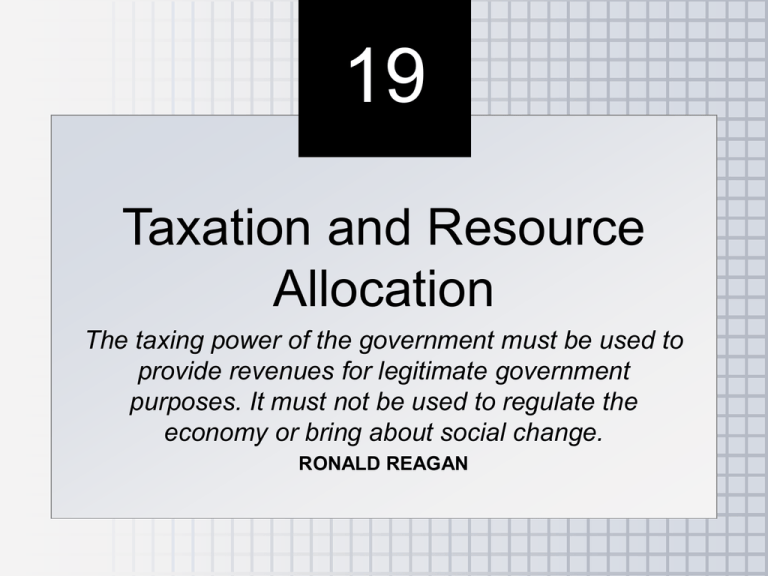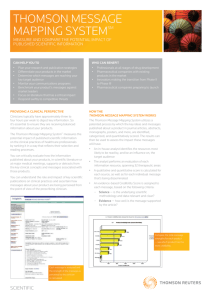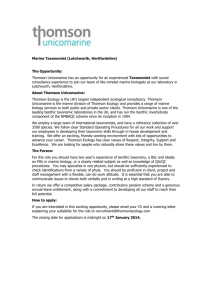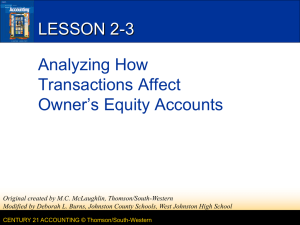
19
Taxation and Resource
Allocation
The taxing power of the government must be used to
provide revenues for legitimate government
purposes. It must not be used to regulate the
economy or bring about social change.
RONALD REAGAN
Contents
● The Level and Types of Taxation
● The Federal Tax System
● The State and Local Tax System
● The Concept of Equity in Taxation
● The Concept of Efficiency in Taxation
● Shifting the Tax Burden: Tax Incidence
Copyright © 2003 South-Western/Thomson Learning. All rights reserved.
Contents
● When Taxation Can Improve Efficiency
● Equity, Efficiency, and the Optimal Tax
Copyright © 2003 South-Western/Thomson Learning. All rights reserved.
The Level and Types of
Taxation
● Average tax rates have been roughly
constant over the past two decades, at both
the federal and the state and local levels.
● Taxes can be classified in terms of whether
they are progressive, proportional, or
regressive.
Copyright© 2003 Southwestern/Thomson Learning. All rights reserved.
FIGURE
19-1 Taxes as Percentage
of GDP
22
20
Percentage of GDP
18
Federal government
16
14
12
10
State and
local government
8
6
4
2
2001
0
1930
1935
1940 1945
1950
1955
1960
1965
1970
1975
1980
1985
1990
1995
2000
Copyright © 2003 South-Western/Thomson Learning. All rights reserved.
19-2 The Tax Burden in
Selected Countries, 2000
FIGURE
Tax Revenues as a Percentage of GDP
60
53.3
50
42.9
40
41.8
37.8
37.7
35.9
29.0
30
27.1
20
10
0
Sweden
Italy Netherlands
United Kingdom
United States
Germany
Switzerland
Japan
Copyright © 2003 South-Western/Thomson Learning. All rights reserved.
The Level and Types of
Taxation
● Progressive tax = the fraction of income
paid in taxes rises as a person’s income
increases
● Proportional tax = this fraction is constant
Copyright© 2003 Southwestern/Thomson Learning. All rights reserved.
The Level and Types of
Taxation
● Regressive tax = the fraction of income
paid to the tax collector declines as income
rises
● The marginal tax rate, not the average tax
rate, most directly affects economic
incentives.
Copyright© 2003 Southwestern/Thomson Learning. All rights reserved.
The Level and Types of
Taxation
● Direct taxes are levied directly on people;
primary examples are income taxes and
inheritance taxes.
● Indirect taxes are levied on particular
activities, such as buying gasoline, using the
telephone, or owning a home.
Copyright© 2003 Southwestern/Thomson Learning. All rights reserved.
The Federal Tax System
● The principal federal taxes, in descending
order of revenue, are:
♦ The personal income tax
♦ The payroll tax
♦ The corporate income tax
♦ Excise taxes
Copyright© 2003 Southwestern/Thomson Learning. All rights reserved.
19-3 Sources of Federal
Revenue
FIGURE
All other 1.1%
Excise taxes
3.4%
Payroll taxes
(Social Security
taxes and
contributions)
36.4%
Corporate
income
taxes
10.3%
Individual
income taxes
48.8%
Copyright © 2003 South-Western/Thomson Learning. All rights reserved.
The Federal Tax System
● The Federal Personal Income Tax
♦ The personal income tax is generally
progressive, but with many loopholes.
■Every tax loophole encourages particular patterns
of behavior and favors particular types of people.
■Among the major tax loopholes are the exempt
status of municipal bond interest and tax benefits
for homeowners.
Copyright© 2003 Southwestern/Thomson Learning. All rights reserved.
19-1 Federal Personal
Income Tax Rates in 2001
TABLE
Copyright © 2003 South-Western/Thomson Learning. All rights reserved.
The Federal Tax System
● The Payroll Tax
♦ The proceeds of this tax are paid into “trust
funds,” such as Social Security, Medicare, and
unemployment benefits.
♦ The payroll tax is highly regressive.
Copyright© 2003 Southwestern/Thomson Learning. All rights reserved.
The Federal Tax System
● The Corporate Income Tax
♦ Tax applies only to profits, not to income;
wages, rents, and interest paid by corporations
are deducted before the tax is applied.
♦ All large corporations currently pay a basic
marginal tax rate of 35%.
♦ Since WWII, has accounted for a declining
share of federal tax revenue--now just 12%.
Copyright© 2003 Southwestern/Thomson Learning. All rights reserved.
The Federal Tax System
● Excise Taxes
♦ a sales tax on the purchase of a particular good
or service
♦ Sales taxes are mainly reserved for state and
local governments.
♦ A minor source of federal government revenue,
some taxes seek to discourage consumption of
a good, such as cigarettes, by raising its price.
Copyright© 2003 Southwestern/Thomson Learning. All rights reserved.
The Federal Tax System
● The Payroll Tax and the Social Security
System
♦ For the most part, Social Security is not a true
trust fund, but a pay-as-you-go transfer system.
♦ For many years, this system managed to give
every generation of retirees more in benefits
than it had contributed in payroll taxes.
■Population growth
■Wage growth
Copyright© 2003 Southwestern/Thomson Learning. All rights reserved.
The Federal Tax System
● The Payroll Tax and the Social Security
System
♦ “Growth magic” stopped in the 1970s.
■Wage growth stopped.
■Population growth slowed.
■Life expectancy increased.
■Retirement age fell.
♦ The burdens on the payers are increasing over
time.
Copyright© 2003 Southwestern/Thomson Learning. All rights reserved.
The Federal Tax System
● The Payroll Tax and the Social Security
System
♦ Because of recent changes, the system is
currently building up a trust fund, but
projections show that the fund will be depleted
in less than 50 years.
♦ Eventually, taxes will have to rise and/or
benefits will have to be cut.
Copyright© 2003 Southwestern/Thomson Learning. All rights reserved.
The State and Local Tax
System
● State and local governments depend mostly
on sales, excise and property taxes.
● Under the U.S. system of fiscal federalism,
grants (often restricted) are made from
higher to lower levels of government.
● The federal government is currently
devolving increased funds and
responsibilities to state governments.
Copyright© 2003 Southwestern/Thomson Learning. All rights reserved.
19-4 Sources of State
and Local Revenue
FIGURE
From federal
government
18.9%
All
other
28.5%
Property
taxes
16.7%
Income
taxes
(personal
and
corporate)
15.6%
Sales and gross
receipts taxes
20.3%
Copyright © 2003 South-Western/Thomson Learning. All rights reserved.
The Concept of Equity in
Taxation
● The three principles are:
♦ Horizontal equity
♦ Vertical equity
♦ The benefits principle
● It is often difficult to apply these principles
in real situations.
Copyright© 2003 Southwestern/Thomson Learning. All rights reserved.
The Concept of Equity in
Taxation
● Horizontal Equity
♦ Horizontal equity = equally situated
individuals should be taxed equally
♦ The current tax code frequently violates this
principle.
Copyright© 2003 Southwestern/Thomson Learning. All rights reserved.
The Concept of Equity in
Taxation
● Vertical Equity
♦ Vertical equity = unequals should be treated
unequally
♦ Often translated into the ability-to-pay
principle, according to which those most able
to pay should pay the highest taxes
Copyright© 2003 Southwestern/Thomson Learning. All rights reserved.
19-2 Three Alternative
Income-Tax Plans
TABLE
Copyright © 2003 South-Western/Thomson Learning. All rights reserved.
The Concept of Equity in
Taxation
● Vertical Equity
♦ Regressive taxes are generally thought to be
unfair.
♦ There is much less agreement about the relative
merits of progressive versus proportional taxes.
Copyright© 2003 Southwestern/Thomson Learning. All rights reserved.
The Concept of Equity in
Taxation
● The Benefits Principle
♦ Benefits principle of taxation = those who
reap the benefits from government services
should pay the taxes
Copyright© 2003 Southwestern/Thomson Learning. All rights reserved.
The Concept of Efficiency in
Taxation
● Because most taxes induce changes in
behavior, the burden of the tax exceeds the
revenue generated with the result that an
excess burden is created.
● In comparing two taxes that raise the same
total revenue, the one that produces less
excess burden is the more efficient.
Copyright© 2003 Southwestern/Thomson Learning. All rights reserved.
A SIMPLE TAX SCHEDULE
Car
Type
Tax
Cadillac Catera
Chrysler 300
Ford Escort
$1,000
500
0
Copyright © 2003 South-Western/Thomson Learning. All rights reserved.
The Concept of Efficiency in
Taxation
● Tax Loopholes and Excess Burden
♦ When tax loopholes exist, economic choices
are distorted by tax considerations.
♦ This impairs economic efficiency.
Copyright© 2003 Southwestern/Thomson Learning. All rights reserved.
Shifting the Burden of
Taxation: Tax Incidence
● Incidence of a tax = an allocation of tax
burden to specific individuals or groups
● Flypaper theory of tax incidence = theory
that the tax burden always sticks where the
government puts it
♦ This theory is often wrong because the people
who pay a tax are often able to shift its burden
to other people.
Copyright© 2003 Southwestern/Thomson Learning. All rights reserved.
19-5 The Incidence of an
Excise Tax
FIGURE
Price of Luxury Cars, Including Tax
S1
D
Tax = $1,000
S0
$40,600
B
Rise in
price = $600
$40,000
A
D
S1
S0
Number of Luxury Cars
Copyright © 2003 South-Western/Thomson Learning. All rights reserved.
Shifting the Burden of
Taxation: Tax Incidence
● The Incidence of Excise Taxes
♦ The incidence is determined not by who
physically pays the tax, but by the elasticities
of supply and demand.
♦ The more inelastic the demand (supply), the
larger is the share of the tax that consumers
(producers) pay.
Copyright© 2003 Southwestern/Thomson Learning. All rights reserved.
19-6 An Extreme Case of
Tax Incidence
FIGURE
Price of Luxury Cars, Including Tax
D
S1
S0
$41,000
Rise in price
= $1,000
$40,000
Tax
= $1,000
S1
S0
D
Number of Luxury Cars
Copyright © 2003 South-Western/Thomson Learning. All rights reserved.
19-7 Another Extreme
Case of Tax Incidence
FIGURE
Price of Luxury Cars, Including Tax
S
D
$40,000
D
S
Number of Luxury Cars
Copyright © 2003 South-Western/Thomson Learning. All rights reserved.
Shifting the Burden of
Taxation: Tax Incidence
● The Incidence of the Payroll Tax
♦ The incidence is the same whether it is levied
on employers or employees.
♦ Because the supply of labor is probably less
elastic than the demand, the incidence falls
mostly on workers.
Copyright© 2003 Southwestern/Thomson Learning. All rights reserved.
When Taxation Can Improve
Efficiency
● Some taxes that change behavior are
nevertheless good because:
♦ They help to achieve some other goal.
♦ They compensate for an inefficiency in the
market. (See, for example, the discussion of
pollution taxes in Chapter 20.)
Copyright© 2003 Southwestern/Thomson Learning. All rights reserved.
Equity, Efficiency and the
Optimal Tax
● All taxes have some negative effects in
terms of efficiency and equity.
● The comprehensive personal income tax
with no loopholes is the best we can do.
Copyright© 2003 Southwestern/Thomson Learning. All rights reserved.
?
The Pros and Cons of the
Bush Tax Cuts
● First: Reduced marginal tax rates
♦ improved economic efficiency
● Second: tax cuts skewed toward upperbrackets
♦ con: why rich get large breaks?
♦ Pro: people who received largest breaks, paid
most in taxes
Copyright© 2003 Southwestern/Thomson Learning. All rights reserved.
?
The Pros and Cons of the
Bush Tax Cuts
● Third: large magnitude once phased in
♦ government afford “generosity”?
♦ Bush argued surpluses justified but surpluses
disappeared after Sept. 11
● Conclusion: It is public policy debate with
plenty of room for reasonable people to
disagree.
Copyright© 2003 Southwestern/Thomson Learning. All rights reserved.







